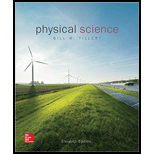
Physical Science - With Lab Manual
11th Edition
ISBN: 9781260021417
Author: Tillery
Publisher: MCG
expand_more
expand_more
format_list_bulleted
Concept explainers
Question
Chapter 11, Problem 36AC
To determine
From the following options, salt solutions freeze at a lower temperature than pure because:
(a) more ionic bonds are present.
(b) salt solutions have a higher vapor pressure.
(c) ions get in the way of water molecules trying to form ice.
(d) salt naturally has a lower freezing point than water.
Expert Solution & Answer
Want to see the full answer?
Check out a sample textbook solution
Students have asked these similar questions
6.a)What do covalently bonded atoms form? __________________________
b) Describe the attractive forces between the atoms in a molecule and between molecules.
Why do molecular compounds have low melting and boiling points compared to ionic compounds?
Covalent compounds are soft and squishy compared to ionic compounds. Describe the analogy used to help us understand this comparison.
Do covalent compounds conduct electricity when they are mixed with water? Explain.
1. When a liquid becomes a solid does it expand or contract?
2.Predict why it is hard to elevate or depress the temperature of water.
3. Compare and contrast how solid solutes and gas solutes differ in their relationship to solubility. Is one more or less soluble than the other, and why?
4. Research one other solute that can depress the temperature of water. Provide the name of the solute and how far it will depress temperature. Does this surprise you?
5.Predict whether large salt crystals or small crystals would lower the temperature faster; explain your answer in detail.
a) If a solute dissolves in a solvent, can you retrieve the solute? b) If so, suggest a method to retrieve the solute from your Ziploc bag. c) If not, why not?
Chapter 11 Solutions
Physical Science - With Lab Manual
Ch. 11 -
1. In the average U.S. home, the heaviest use of...Ch. 11 -
2. Freshwater is obtained from all of the...Ch. 11 - Prob. 3ACCh. 11 - Prob. 4ACCh. 11 -
5. Fluids that mix in any proportion without...Ch. 11 - Prob. 6ACCh. 11 - Prob. 7ACCh. 11 - Prob. 8ACCh. 11 - Prob. 9ACCh. 11 - Prob. 10AC
Ch. 11 - Prob. 11ACCh. 11 - Prob. 12ACCh. 11 - Prob. 13ACCh. 11 - Prob. 14ACCh. 11 - Prob. 15ACCh. 11 - Prob. 16ACCh. 11 - Prob. 17ACCh. 11 - Prob. 18ACCh. 11 - Prob. 19ACCh. 11 - Prob. 20ACCh. 11 - Prob. 21ACCh. 11 - Prob. 22ACCh. 11 - Prob. 23ACCh. 11 - Prob. 24ACCh. 11 - Prob. 25ACCh. 11 - Prob. 26ACCh. 11 - Prob. 27ACCh. 11 - Prob. 28ACCh. 11 - Prob. 29ACCh. 11 - Prob. 30ACCh. 11 - Prob. 31ACCh. 11 - Prob. 32ACCh. 11 - Prob. 33ACCh. 11 - Prob. 34ACCh. 11 -
35. The ice that forms in freezing seawater...Ch. 11 - Prob. 36ACCh. 11 - Prob. 37ACCh. 11 - Prob. 38ACCh. 11 - Prob. 39ACCh. 11 - Prob. 40ACCh. 11 - Prob. 41ACCh. 11 - Prob. 42ACCh. 11 - Prob. 43ACCh. 11 - Prob. 44ACCh. 11 - Prob. 45ACCh. 11 - Prob. 46ACCh. 11 - Prob. 47ACCh. 11 - Prob. 48ACCh. 11 - Prob. 49ACCh. 11 - Prob. 1QFTCh. 11 - Prob. 2QFTCh. 11 - Prob. 3QFTCh. 11 -
4. A deep lake in Minnesota is covered with ice....Ch. 11 - Prob. 5QFTCh. 11 - Prob. 6QFTCh. 11 - Prob. 7QFTCh. 11 - Prob. 8QFTCh. 11 - Prob. 9QFTCh. 11 - Prob. 10QFTCh. 11 -
11. Explain why a pH of 7 indicates a neutral...Ch. 11 -
1. What are the basic differences and...Ch. 11 -
2. Compare and contrast the situations where you...Ch. 11 - Prob. 3FFACh. 11 -
4. What is the same and what is different between...Ch. 11 - Prob. 5FFACh. 11 - Prob. 6FFACh. 11 - Prob. 7FFACh. 11 - Describe at least four different examples of how...Ch. 11 -
1. What is the percent by weight of a solution...Ch. 11 -
2. What is the percent by weight of a solution...Ch. 11 - Prob. 3PEBCh. 11 -
4. What is the volume of water in a 500 mL bottle...Ch. 11 -
5. If a definition of intoxication is an alcohol...Ch. 11 -
6. How much pure alcohol is in a 355 mL bottle of...Ch. 11 - Prob. 7PEB
Knowledge Booster
Learn more about
Need a deep-dive on the concept behind this application? Look no further. Learn more about this topic, physics and related others by exploring similar questions and additional content below.Similar questions
- State the short general principle of solubility, and explain what it means.arrow_forwardYou decide to have hot dogs for dinner. In the grocery store, you find that buns come only in packages of 12, whereas the hot dogs come in packages of 8. How can your purchases lead to having no buns or hot dogs left over? (How does this problem fit in with chemical bonding and other parts of this chapter?)arrow_forwardThe human body converts sugar into carbon dioxide and water at body temperature (98.6F, or 37.0C). Why are much higher temperatures required for the same conversion in the laboratory?arrow_forward
arrow_back_ios
arrow_forward_ios
Recommended textbooks for you
 An Introduction to Physical SciencePhysicsISBN:9781305079137Author:James Shipman, Jerry D. Wilson, Charles A. Higgins, Omar TorresPublisher:Cengage Learning
An Introduction to Physical SciencePhysicsISBN:9781305079137Author:James Shipman, Jerry D. Wilson, Charles A. Higgins, Omar TorresPublisher:Cengage Learning

An Introduction to Physical Science
Physics
ISBN:9781305079137
Author:James Shipman, Jerry D. Wilson, Charles A. Higgins, Omar Torres
Publisher:Cengage Learning